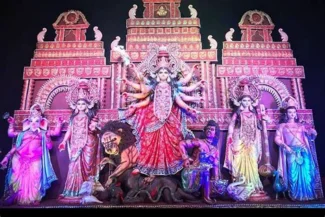~ Tejas Bobe
It is the time of the year when the entire northeast, along with other parts of India lights up. The aartis, the hymns, the celebration, gathering in masses, joyous aura, unending yet pious rituals that have existed over the years, the people celebrating together, all combined results in one of the biggest festivals of India, the Durga Puja.
What is Durga Puja about?
As the name suggests, Durga Puja is a festival associated with Goddess Durga. Durga Puja is a festival that originated in Bengal and is popularly celebrated in the North-eastern states and Bangladesh, along with different parts of India as well as Nepal. It marks the victory of Goddess Durga over Mahishasura, hence it also marks the victory of good over evil. It is a ten-day-long festival celebrated in the month of Ashwin, which corresponds to September/October. Out of the ten days, the last five are of the most significance, with the 10th day marking Vijaya Dashami, or the victory of the goddess over the asura. Durga Puja coincides with Navratri and Dussehra, the festivals that are associated with the victory of Lord Rama over Ravana, and is celebrated with equal grandeur throughout India.
How is it celebrated?
To mark the celebrations, huge pandals are erected to house the idols, which are also decorated magnificently. Usually, the decorations have a meaning of their own with different themes and vibes. Sometimes, even short plays are enacted which depict various mythological events. The festival ends on the tenth day, where huge processions are organised and the idols are immersed in rivers.
Even though the exact origins of the festival are unclear, it is known to be celebrated since the 14th century, especially among the royalties and the wealthy. Ever since, the festival has become a part of the culture, with its splendour and significance increasing tremendously among the masses. Its importance increased during the British colonial times, and it has been so ever since. Today, it is much more of a cultural and communal festival than a religious one. People use it as an occasion to get together and enjoy, forgetting their differences, and the festive spirit bringing people together. As a part of the celebration, aartis are organised every day. A huge crowd gathers, where people pray together. Durga Puja in Kolkata is probably the biggest celebration of the festival. Huge pandals which house statues of Goddess Durga along with the smell of shewli (a flower) and the sound of dhaak (drums) make up the heartwarming atmosphere in Bengal. Usually, the pandals are associated with grand decorations which follow a theme. Another astonishing fact is the religious harmony among all the religions which is seen during the Durga Puja, wherein the festival is celebrated communally with feelings of harmony and brotherhood.
How it was during the pandemic- COVID 19?
As we already know, this is one of the most important festivals and is celebrated on a large scale. However, the ongoing pandemic has hampered the Durga Puja celebrations this year. As a result, the government has restricted the entry of citizens into the pandals. These restrictions are seen as important measures against the spread of the virus. This has, however, not affected the festive spirit. Despite the restrictions, people are still celebrating it while also taking the necessary precautions. Whatever the scenario be, it is difficult to deprive people of the festive spirit. In fact, to counter the restrictions, people have started to use innovative methods to celebrate it. Many pandals have decided to organize digital pujas, where they can live stream the pujas and the devotees can participate in it. It is one of the best alternatives to counter the situation.
Over the years the grandeur of the festival has increased, thanks to the increasing importance among the people. It has resulted in increasing grandness, the way people celebrate and more excitement. The festival is a great example that even though we might be headed towards westernisation, festivals are the ones who take us back to our roots.
Must Read: The different theological history behind Diwali and some myths





